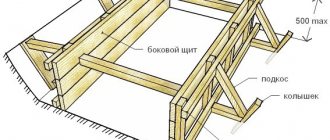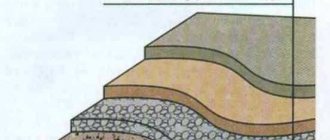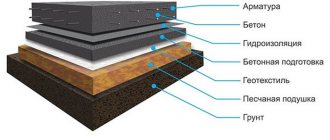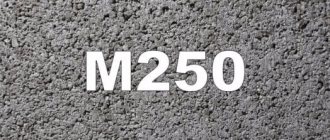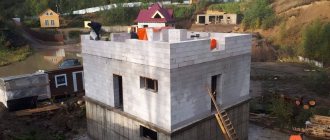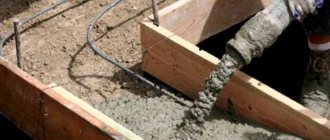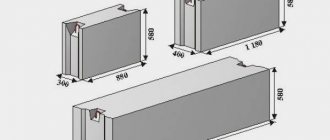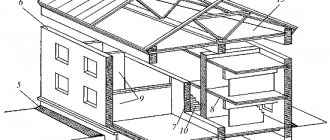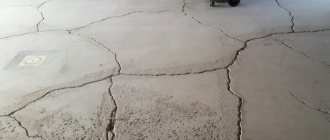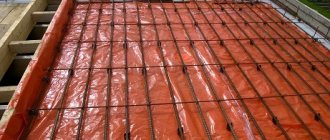- Concrete grades for mortar
- Calculation of concrete mixture proportions
- Stages of pouring floors
- It's time to move on to filling
In order for concrete floors to be strong and reliable, it is necessary not only to perform the pouring correctly, but also to strictly follow the technology.
Remember, the strength and reliability are affected by the correctly selected proportion and brand of concrete for the solution. The strength and reliability of concrete floors largely depend on the correct ratio of concrete mortar components and pouring technology.
What kind of concrete can be used and under what circumstances, how to calculate the proportion for pouring? How should floors be poured and reinforced? Let's take a closer look at all of the above questions.
Concrete grades for mortar
For interfloor floor slabs, you need to use high-quality concrete that can withstand heavy loads.
The ceiling is a significant part of the structure. To prepare the necessary concrete mixture for pouring a reliable ceiling, you must select the right grade of concrete.
- Grade M-100 is the lowest grade of concrete; it is used for pouring cushions under platforms and concrete stairs, before starting to pour the strip foundation.
- M-150 is used for small foundations and floor screeds.
- M-200 is a more durable concrete, it is used for pouring floors, screeds, blind areas, concrete stairs, and small areas.
- M-250 can be used for pouring floor slabs, the loads on which are not expected to be very large. This type of concrete is used for monolithic foundations, stairs, retaining walls, strip fences and more.
- Brand M-350 is the best option for the manufacture of concrete floor slabs, monolithic foundations, beams, crossbars, and swimming pool bowls. This brand can withstand quite heavy loads while maintaining its properties. Such concrete is usually used even in the construction of airfield slabs, which indicates its high quality.
- M-400 is a rather rare and expensive option. This concrete is super strong, but it is not advisable to use it for constructing slabs in a private house.
- M-450 and M-500 - concrete is very high quality and durable, but it is used mainly for hydraulic structures.
Return to contents
Calculation of concrete mixture proportions
Calculating the proportions of the concrete mixture is a very responsible matter. In order for the quality of the composition to be at its best, it is necessary to fully comply with the technology and adhere to the adopted requirements. You can use concrete for floors only of certain grades that can withstand the expected loads. The best option is brand 350; the use of four hundred or five hundred is extremely rare, since they are too expensive.
The mixture is made not only on the basis of cement, but also with the use of sand, crushed stone, and other additives can be used, anti-frost ones are especially popular.
Correctly calculating the proportions of the mixture for pouring can only be done taking into account numerous factors. These include the fraction of added crushed stone and sand, density, requirements for the future mixture, for example, its resistance to loads, its mobility, water resistance and much more. In order to properly prepare the solution for pouring, it is necessary to take into account the relationships between its individual components. Cement, as a rule, is taken as a unit, and all other components are taken in relation to the weight of cement.
To prepare a concrete solution you will need cement, sand, and crushed stone. The proportions of the components depend on the brand of cement.
For example, if 25 kg of cement, 75 kg of sand, 125 kg of crushed stone are required, then their ratio is usually expressed as follows: 25 * 75 * 125 or 1 * 3 * 5. This means that 1 part of cement is taken, 3 parts of sand, 5 parts of crushed stone.
All proportions are calculated based on the grade of concrete and the required parameters:
- for M-300 the mass composition is taken in the following ratio: 1 * 1.9 * 3.7. In this case, the amount of concrete produced from ten liters of cement is 41 liters;
- for M-400 the ratio is 1*1.2*2.7. The resulting amount of concrete will be equal to 31 liters for every 10 liters of cement taken.
The amount of water should be just enough so that the kneaded mixture is sufficiently plastic, but not too hard.
Return to contents
Mixture composition
The composition of any concrete solution includes the following components: cement, crushed stone or gravel, sand, water. The mixture is prepared in a concrete mixer, which ensures a higher quality of mixing and, accordingly, the final solution than with the manual method.
The main component of a concrete mixture is cement, the consumption of which depends on the brand of the finished mixture. Sand is chosen from river sand or any sand (but pre-cleaned from clay, which can make the sand greasy and unsuitable for work). Crushed stone is chosen in fractions of 10-20 millimeters; it must be clean, without screenings and debris. Add clean water, without any impurities, so that the solution does not separate.
Stages of pouring floors
The thickness of concrete floors in a residential area must be at least 15 cm to ensure sufficient sound insulation.
Once the solution for pouring the ceiling is ready, you can begin to work. It is this method that makes construction cheaper, since monolithic slabs are very expensive, and the use of such pouring on site, although more complex, is still much cheaper. One of the advantages of the method is that in this case there is no need to use heavy lifting equipment.
But this does not mean that when building a private residential building you can act independently. In this case, the participation of specialists is necessary, since creating concrete floors requires certain experience.
The following stages of work are followed:
- Be sure to pay attention to the thickness of the future ceiling. In order, in addition to strength, to ensure proper sound insulation, it is necessary to make panels with a thickness of no less than 12 cm. But this size is suitable for non-residential premises, but for residential premises the thickness should be from 15 cm. In such calculations, many factors are taken into account, including strength , ability to withstand expected loads, level of noise insulation.
- The dimensions of the ceiling itself may vary. The optimal size is considered to be 250*300 cm. In this case, a metal channel is used as a basis, thrown from one wall to the opposite. Such beams come in increments of 0.5 m. Three beams are enough for the floor frame.
- After laying the beams, you need to start formwork. It is made from supports and wooden panels. You can limit yourself to boards 20 mm thick, which are knocked together using ordinary nails. For formwork, similar panels with dimensions of 125 * 125 cm are used; simple timber and boards are used as supports. At least eight supports are placed on the prepared shield; thin plywood must be mounted on the inside; it will not allow the concrete mixture to leak out. A similar formwork is placed 5 cm from the bottom edge of the beams.
Reinforcing the concrete screed with metal mesh, pipes or reinforcing rods increases the load-bearing capacity of the floor.
After installation, you need to start reinforcing. For this purpose, metal mesh for plastering work, iron rods, and metal profile pipes are used. All pipes must be welded to the frame beams in increments of 60 cm, resulting in a lattice. Rods are placed parallel to the channels at a distance of 20 cm and screwed to the profile pipes. In this way, massive strengthening of the future floor is carried out.
Increasingly, monolithic ceilings are being installed in residential buildings. What do you need to know before choosing this option?
What is needed to make a monolithic ceiling?
1) We need a project. The specialist, having made a calculation, will determine the optimal thickness of the floor and its reinforcement. This is the only way to make the roofing in your home truly economical. Let’s say you decide to save money and adopt the thickness and reinforcement of the ceiling “like your neighbor’s”, and add a little extra of your own for safety. As a result, you have a slab 200 mm thick, reinforced with reinforcement with a diameter of 14 in increments of 200 mm, made of class B25 concrete. Let's assume your floor area is 9 x 9 = 81 m2. So, let’s calculate using the first prices found on the Internet:
Concrete: price 435 UAH/m 3, consumption 16.2 m 3 - total 7047 UAH.
Reinforcement: price 7500 UAH/t, consumption 1.96 t – total 14700 UAH.
Now, again, let’s assume that you ordered a flooring project from a specialist, and he designed the following for you: a slab 180 mm thick, reinforced with reinforcement with a diameter of 12 in increments of 200 mm, made of class B20 concrete. Let’s not be too lazy to calculate the cost:
Concrete: price 390 UAH/m 3, consumption 16.2 m 3 – total 6318 UAH.
Reinforcement: price 7500 UAH/t, consumption 1.44 t – total 10800 UAH.
As a result, you save 4629 UAH. A floor drawing will cost you much less, believe me.
2) You need to find a builder who will provide high-quality work and will not bother you with the search for formwork, scaffolding and materials. Find out if his company is licensed. But the main thing is a reputation confirmed by friends. You are building a house for the rest of your life, and your children and grandchildren will also have to live in it, so find the most responsible specialists.
What should a competent and experienced builder know?
Of course, he must be able to read drawings, otherwise the project you ordered may turn out to be a waste of time and money. Now there are many unfortunate builders who say: why do I need a project, I know how to do it better and cheaper. If you come across just such “you with a mustache”, refuse to work with them and look for specialists. What else? The builder must know the technology of concrete work. There are many nuances that need to be ensured during construction. Protective layers for working reinforcement, joining reinforcement, placing it on a support, making working concreting joints, caring for concrete after concreting, laying and compacting the concrete mixture with vibrators... All of the above, and much more, is a necessary condition for high-quality performance of work.
What kind of concrete is needed for a monolithic floor?
The strength class of concrete depends on the results of the floor calculation. Basically, concrete classes B15, B20 and B25 are accepted - the larger the spans and loads, the higher the concrete class. In addition to the strength class, concrete also has requirements for frost resistance and water resistance. For the floors of heated houses, the following grades are sufficient: frost resistance F 50, water resistance - not standardized. If the ceiling has balconies, then the required grade for frost resistance and water resistance depends on the climatic region; it can be determined from table 4(9) of the Manual for the design of concrete and reinforced concrete structures made of heavy and light concrete (to SNiP 2.03.01-84).
Read more about frost resistance and water resistance in this article “How to determine concrete grades by frost resistance and water resistance according to DBN V.2.6-98:2009 “Concrete and reinforced concrete structures”
What reinforcement is used to reinforce a monolithic floor?
Working fittings are used class A400S, hot-rolled periodic profiles made of steel grade 35GS or 25G2S. The diameters of the working fittings vary from 8 to 16 mm. The main reinforcement is the lower one, due to the fact that the ceiling works in bending, and the lower zone of the slab is the most stretched (and therefore the most reinforced). The upper reinforcement is often taken into account structurally, and its diameter may be smaller than that of the lower one. The exception is the floor areas at the points of support - here, according to calculations, reinforcement is often required in the upper zone of the slab. And for large spans, as well as when supported by columns, it becomes necessary to install transverse reinforcement in the form of clamps or frames. Transverse reinforcement class A240C.
What is the optimal floor thickness?
It all depends on the span, i.e. on the distance between walls or columns. For a residential building, the thickness of the floor can vary between 150...200 mm. Moreover, a floor thickness greater than 180 mm must be justified by calculation, since an increase in the thickness of the slab significantly increases the load on it, and in certain cases impairs performance.
Attention!
For the convenience of answering your questions, a new section “FREE CONSULTATION” has been created.
Comments
« 18 19 20 21 22 23 24 25 26 27 28
1 #812 Irina 02/17/2014 21:08
I quote Ilya:
Irina Hello! I haven't heard from you for a long time. Regarding my question, can you help me with the calculation?
Ilya, make square slabs 150mm thick, bottom reinforcement ten with a pitch of 200x200mm, along the top (required) a mesh of smooth six.
Rectangular - also 150mm thick, reinforcement along the short direction - ten in increments of 200mm, along the long direction - maybe six smooth. Upper reinforcement is also required, because support on 4 sides. Under the stairs - pour a concrete stump into the underground. Concrete is the main building material for the construction of multi-story buildings, but it is needed not only for them. Even the construction of private houses made of wood is not complete without a concrete foundation, not to mention the widest use of reinforced concrete products in the industrial construction industry. All types of lightweight concrete, expanded clay concrete, and cinder blocks are used for the construction of various structures; paving slabs and curbstone curbs are very popular in landscaping , made by vibration pressing.
Lightweights are divided into two types: structural and thermal insulation.
Nevertheless, the main purpose of this building material is still the creation of foundations, columns, floor slabs and other reinforced concrete products intended for residential and industrial construction.
What concrete to use for the foundation: choice of brand, protection
Brand of concrete for constructing a foundation slab
- A little history of the origin of concrete
- Concrete, grades, selection criteria
- Concrete mixtures, their brands and proportions
- Slab foundation - how to choose suitable types of building materials? Installing a slab foundation with your own hands - basic nuances and recommendations
In any construction, from residential buildings to commercial buildings, it is necessary to have sufficiently durable material. Today, concrete performs its function very well. But before concrete appeared in our lives, more than one millennium passed. Next we will talk about which brand of concrete for a foundation slab is considered the most suitable and about some other nuances of constructing a monolithic foundation. But first, let's talk about the origin of concrete as a building material.
Table of concrete grades and operating modes.
There were times when, instead of concrete mortar, a mixture consisting of clay, water and greasy soil was used for construction. This building material is quite many years old, more than 10,000. It had a unique tensile strength and was used for the construction of various structures with great success.
Table of ratios of cement, sand and crushed stone in concrete production.
The next composition, prior to the advent of concrete, was a solution based on lime and gravel. The buildings erected with the help of this composition have survived to this day, of course, in the form of ruins. This construction took place a long time ago, about 8,000 years ago. Now this date is considered the beginning of the era of concrete construction.
Modern concrete firmly entered our lives only at the beginning of the 19th century. At this time, cement was invented, which is the main binder in concrete and other building mixtures.
The construction of foundations using monolithic reinforced concrete slabs has become especially popular in recent years. This type of foundation is distinguished by its production right on the construction site. The main component for it is concrete.
Today, ready-made blocks with standard shapes and sizes are becoming a thing of the past. This is due to the possibility of producing monolithic products of any desired shape using liquid concrete mixture. This means that you can easily use any type of foundation during construction, and its installation will not cause you much trouble.
Monolithic construction technology is gaining popularity in Russia and has almost completely replaced the costly technology of “brick” construction of low-rise and high-rise buildings.
ContentsCollapse
At the same time, for the construction of buildings and structures or their individual elements, not all types of concrete can be used, but only certain grades of monolithic concrete produced in accordance with the requirements of the current regulatory document - GOST 26633-2012 and an outdated but still relevant document - GOST 26633-91 “The concrete is heavy and fine-grained.”
This document describes all existing brands of heavy concrete. At the same time, not all brands can and are used for pouring walls, columns, ceilings and other elements. The applicability of certain grades of concrete in monolithic construction will be discussed in this article.
Building and structural material of this type is the most in demand and, depending on the brand, is used for the construction of: load-bearing walls, concrete stairs, floor slabs, strip, pile-grillage, monolithic and slab foundations, load-bearing columns, crossbars, swimming pool bowls, all kinds of platforms and blind area.
Thus, the determining factor in the use of heavy concrete is its strength and strength class, which differentiate this material by its compressive strength at the age of 28 days after mixing the concrete components with water.
Let's consider existing brands and classes of concrete, as well as which brands and classes of concrete are in demand in monolithic construction
In order to accurately determine what the best brand of concrete for a monolithic slab will be in all respects, when choosing, you need to pay attention to a number of factors:
- geological conditions: groundwater level, structure and type of soil prevailing in the area;
- climatic features of the area: air humidity, characteristic temperature conditions;
- type of building, number of storeys and expected loads.
We invite you to familiarize yourself with Crafts on a plate in autumn
Each of these factors must be taken into account when choosing a brand of mortar for creating monolithic structures. The grade of concrete for the slab will be chosen correctly only with an integrated approach to solving this problem.
Concrete specialists provide assistance in choosing the appropriate modification of concrete, provide services for the production and delivery of the mixture to the construction site.
Today, a wide variety of buildings are being erected using the monolithic construction method - country and private houses, shopping and entertainment centers, multi-storey buildings, utility and industrial buildings.
When constructing light, small-sized buildings on sandy, rocky and other hard soils, compositions M150 or M200 are quite suitable grades of concrete for the foundation slab. For more massive and heavy buildings under similar conditions, it is more advisable to use concrete M300 or M350.
Clay soils are characterized by high heaving content; when it freezes, its volume increases significantly. The optimal grades for such soils are considered to be M350-M400.
The greater the weight of the object being built, the higher the grade of concrete for the monolithic foundation slab should be used in the construction process. This rule applies to any soil.
The strength, stability and durability of the building directly depends on the correct choice of class and brand of concrete mixture. Concrete produces all popular brands of specialized concrete with maximum compliance with the required parameters.
The plant's assortment includes various building mixtures, from which you can choose the most suitable ones in terms of frost resistance, water resistance, density, mobility and strength class.
The plant produces any brand of concrete for a foundation slab or floor slab in a short time and in any quantity. The solution is delivered throughout St. Petersburg and the Leningrad region.
Foundations for private housing construction are often constructed using concrete castings. This can be a strip concrete foundation reinforced with a metal spatial mesh or a monolithic foundation base in the form of a slab.
Brand of concrete for the foundation
Concrete can also be used to form support pillars, which can be used either independently or in a combined strip-column foundation support.
The main components of a concrete mortar for foundation support in private housing construction are a binder, a fixing substance (in the vast majority of cases cement is used), fillers (which are sand, crushed stone or a combination of both), and water. Various specialized additives can also be added to the concrete solution. They serve to impart special characteristics to the concrete casting, such as frost resistance.
Depending on the combination of the described ingredients, their quality and various additives, concrete solutions have different grades. Each brand of concrete mortar was developed by technologists to perform a specific type of work and create concrete castings that perform various functions.
Many people start choosing concrete for the foundation, although the brand may be different, even at the planning stage of the building. And they do it right, because, regardless of what purpose the building is planned for, the foundation is the basis of everything and is considered an important detail. Builders have a lot of responsibility in how they build and what materials they use.
When choosing cement, you need to pay attention not only to what brand of concrete is needed for the foundation of the house, but also to its various parameters. For example, it is imperative to study indicators of resistance to loads and the influence of aggressive environmental conditions, durability and safety.
The grade of cement for the foundation of a house is designated as “M”. O indicates the class of the substance. The letter “P” will help determine the mobility parameters of a substance. The "W" indicates how water resistant the cement will be. O is related to how resistant a substance is to low temperatures.
The grade of concrete for the strip foundation of a private house or other types of structures is the main characteristic. It shows what load and how exactly the cement itself will carry. You can also find out about compression after it hardens (a month is taken into account).
For example, grade M100 B7.5 indicates that the cement has a relatively low level of quality. In most cases, a similar brand is used for work at the initial stage. This material can be useful to build cement pads for the foundation itself.
The M150 B12.5 indicator shows that the cement will not be of very high quality. Most often it is used to create cement paths. It is also suitable for rough-type screeds.
The M200 B15 index in the name indicates that in the future the substance can be used for construction purposes, but only where there will not be too heavy loads. For example, this brand of concrete will definitely work for a strip foundation. Belt slabs will be of excellent quality if all production rules are followed.
M300 B22.5 is considered the most common and popular brand. This is especially true for Russia and the CIS countries. The quality of this product can be considered, but strictly “good”. Most often, the material is used to fill the foundations of country houses.
The grade of concrete for the foundation of a two-story house is also M300 B22.5. But if you need increased strength, it is better to use products with an M350 B25 indicator. A product with this parameter is used for buildings and structures that require an increased level of strength.
Less often in Russia and the CIS countries they resort to cement marked M500 B40. This rare product is mainly suitable only for special construction sites and storage facilities in banks, since the strength will be maximum, but you will have to pay a lot of money for such luxury. So it is not advisable to use this option for building a regular house.
Classification
The widespread use of this material implies its species diversity. Usually classified according to such indicators as the type of binder, density and direct purpose. The most famous and popular type of binder is, of course, cement. When talking about reinforced concrete products, they most often mean building materials made from Portland cement, water and aggregates. Gypsum, liquid glass, slag and alkaline elements, less often lime, etc. are also used as binders. These substances are used to produce special concretes used under special conditions or for performing narrow-profile work.
Based on density, types are divided into heavy ones, using aggregates such as limestone or granite, and light ones (aerated concrete, foam blocks, etc.), in the production of which porous aggregates are used. The purpose depends on the density. Heavy ones are used in the construction of hydraulic structures, airfield pavements, anti-radiation protective structures, that is, wherever high strength or frost resistance of structures is required. Lightweight ones are very good for the construction of low-rise buildings or for monolithic frame construction (foam concrete). Conventional reinforced cement concrete is a classic material for foundations and floors. It is the production of reinforced concrete floor slabs that will be discussed further.
Floor slabs are produced by reinforced concrete factories from dense structure, heavy, and also dense silicate. They are intended for use in the load-bearing part of residential buildings and industrial buildings. Floor slabs can be solid or multi-hollow with different thicknesses and diameters of the voids. Voids in reinforced concrete floors are necessary to ensure sound insulation qualities, while concrete is removed from low-stressed parts of the slab. The length of the floor slab can be from 2.8 to 6.4 m, and in some cases more. The width of the slab can reach up to 3.2 m. The main indicator for the floor slab is the thickness. The minimum thickness for hollow core slabs is about 25-30 mm, for ribbed slabs - 50-60 mm. The latter are used primarily in industrial construction, while hollow cores and conventional solid ones are used in the construction of residential and administrative buildings.
In the process of manufacturing floor slabs at concrete factories, various technologies are used, each of which includes operations such as:
- reinforcement tension;
- molding of reinforced concrete products;
- hardening of the mixture;
- cutting on panels to the required length.
Equally important is the production of a high-quality mixture used when molding the product, so the proportions of the concrete components may vary depending on the expected loads of the finished slab.
Concrete mix
To make a concrete mixture with your own hands you will need: the components of the concrete mixture, a shuffle shovel, a garden wheelbarrow.
The optimal grades for the production of floor slabs are M300-M350. The grade of concrete is directly related to the amount of cement in the concrete mixture; the grade numbers on average indicate the compressive strength. Production of the M300 grade is possible using crushed stone from limestone, gravel and granite, M350 - based on gravel and granite crushed stone. But the main component of the mixture remains cement, the most popular now is Portland cement grade 400. (cement, sand, crushed stone) using cement of this grade should be as follows: 1: 1.9: 3.7. If higher quality cement grade 500 is used, then the proportions change and will look like 1: 2.4: 4.3. For M350 concrete using grade 500 cement, the ratio should be: 1:2:4. The more cement in the mixture and the stronger it is, the higher quality and reliable concrete can be obtained as a result. should not exceed a coefficient of 0.7.
Thus, when calculating the proportions of the mixture, it is necessary to take into account many factors: the size of the crushed stone or sand fractions, the quality of the sand and the amount of water used during mixing. When choosing certain components, the qualities that need to be imparted to the future concrete are taken into account: elasticity, frost resistance, resistance to deformation, etc. In order for the concrete to be of high quality, the crushed stone fractions must be 5-20 mm in size, and the sand must be quartz and must be clean , without any impurities. To make the mixture, it is better to use a concrete mixer, but if you make concrete with your own hands, you will need:
- mixture components;
- shuffle shovel;
- garden wheelbarrow;
- large mixing containers.
Composition and proportions of the material
Strength depends on the elements used: cement, sand, crushed stone. It must be remembered that adding an excessive amount of water will ensure that the cement mortar hardens slowly. And disproportionate use of other components can lead to rapid wear of the concrete product. So, we advise you to use materials in accordance with regulations. For example:
- The norm when using M250 is 1:2.6:4.5. When calculating the proportion, you need to take into account the water content, the size of the sand, and the quality of the filler.
- When using M300 grade cement, the proportion is 1.2:4.4:3. When constructing high-rise buildings: 1.2:4.
To prepare the highest quality mixture, it is recommended to use a concrete mixer during the manufacturing process. Hand kneading cannot compare to the work of a stirrer.
The grade of concrete for a monolithic floor is a parameter that will have a direct impact on the strength of the structure, its resistance to various mechanical influences, loads, moisture, temperatures, and also determine the final cost. Therefore, you need to choose a brand that provides the ideal ratio of the desired properties and price.
Brands of concrete differ in the composition of the components: their type and proportions. Various additives can also be added to the mixture to improve certain parameters: frost resistance, strength, resistance to moisture or chemical influences. It is important to take into account the conditions in which the concrete will be used. An important characteristic of the solution is its weight per cubic meter - it is desirable that the value does not exceed 1500 kilograms per cubic meter.
Today there are several grades of concrete on the market with different properties - from M100 to M500.
Slab production
The quality of the future reinforced concrete product also depends on the correct pouring of the concrete mixture. It is possible to make reliable concrete using the required proportions of the components, but poor-quality molding of the product will lead to manufacturing defects. Precast concrete factories use special machines for molding reinforced concrete products, although floor slabs can also be made on your own. In this case, floor slabs are made in special wooden forms, upholstered on the inside with a moisture-resistant material such as linoleum. A metal mesh is placed in the formwork to reinforce the concrete mixture. The diameter of the metal wire that makes up the mesh should be 4-6 mm, and the mesh size should be 10-15 cm.

